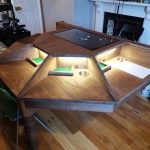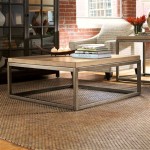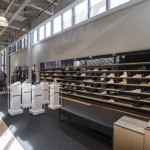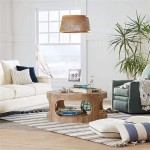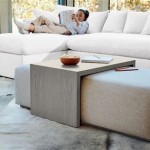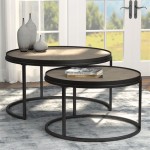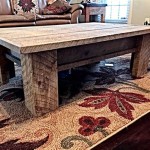Making The Most Of Wooden Coffee Table Legs
Wooden coffee table legs are more than just structural supports; they contribute significantly to the aesthetic appeal and overall functionality of a living space. Selecting the right type, style, and finish of wooden legs for a coffee table can profoundly impact the room's ambiance. This article will explore various aspects of utilizing wooden coffee table legs to enhance the design and utility of a coffee table, focusing on materials, styles, installation, and maintenance.
Understanding the Material Palette
The choice of wood for coffee table legs is crucial, influencing not only the appearance but also the durability and stability of the table. Different wood species offer distinct characteristics, each with its own set of advantages and considerations.
Hardwoods, such as oak, maple, and walnut, are known for their density and resistance to wear and tear. Oak, with its prominent grain pattern, is a popular choice for traditional and rustic designs. Maple offers a smoother, more subtle grain, making it suitable for contemporary and minimalist styles. Walnut, prized for its rich, dark color and luxurious feel, adds a touch of elegance to any space. Due to their inherent strength, hardwoods are ideal for supporting heavier tabletops and enduring daily use.
Softwoods, like pine and fir, are generally more affordable and easier to work with. Pine’s light color and knotty texture lend themselves well to casual or farmhouse-inspired designs. While softwoods may not be as durable as hardwoods, they can be adequately reinforced with proper joinery and finishing techniques. They are often a good option for lighter tabletops or projects where cost is a primary concern.
Beyond the species of wood, consider the grain direction and figure. Straight-grained wood is generally more stable and less prone to warping, making it a reliable choice for table legs. Figured wood, with patterns like burl or tiger stripe, can add visual interest but may also require more careful handling during construction.
The sustainability of the wood source is another essential factor. Opting for reclaimed wood or wood certified by organizations like the Forest Stewardship Council (FSC) ensures that the materials are sourced responsibly and contribute to environmentally conscious practices.
Exploring Style and Design Options
Wooden coffee table legs provide a wide range of design possibilities, allowing for customization to suit various interior design themes. From classic to contemporary, the style of the legs can significantly influence the overall aesthetic of the coffee table.
Tapered legs, characterized by their gradually narrowing profile, are a classic choice for mid-century modern and Scandinavian designs. Their sleek and understated appearance adds a touch of refinement to any room. Straight legs, with their simple and unadorned form, are versatile and can be adapted to fit a wide range of styles, from minimalist to industrial.
Cabriole legs, with their distinctive S-shaped curve, evoke a sense of elegance and formality, often found in traditional and French Provincial designs. These legs typically feature decorative carvings and embellishments, adding visual interest and sophistication.
Bun feet, small and rounded legs, are commonly used in traditional and cottage-style furniture. Their charm and simplicity make them a popular choice for creating a cozy and inviting atmosphere. Pedestal bases, consisting of a single, central support, offer a unique and visually striking alternative to traditional four-legged designs. They can be crafted from a variety of wood species and finished in various styles to complement the tabletop.
Beyond these standard styles, consider incorporating custom-designed legs to create a truly unique and personalized coffee table. Working with a woodworker or using online design tools can help bring your vision to life. The diameter or thickness of the legs is also a consideration. Chunky, substantial legs create a more grounded and robust feel, while thinner legs lend themselves to a more delicate and airy aesthetic.
Finally, the height of the legs is important to consider in relation to the tabletop's size and the overall proportions of the room. Standard coffee table height typically ranges from 16 to 18 inches, but this can be adjusted to suit individual preferences and the height of surrounding seating.
Installation Techniques and Structural Integrity
Proper installation of wooden coffee table legs is paramount to ensuring the stability and longevity of the table. Secure and well-executed joinery techniques are essential for withstanding daily use and preventing wobbling or collapsing.
One common method for attaching legs is using metal mounting plates. These plates are typically screwed into the underside of the tabletop and feature threaded inserts for attaching the legs. This method is relatively straightforward and allows for easy removal and replacement of the legs if needed. Ensure the mounting plates are of sufficient size and quality to support the weight of the tabletop and any items placed on it.
Another approach involves using mortise and tenon joints. A mortise is a hole cut into the tabletop, while the tenon is a projecting piece on the leg that fits into the mortise. This type of joint is known for its strength and durability, providing a secure and long-lasting connection. Constructing mortise and tenon joints requires more skill and precision but results in a superior level of stability.
Dowel joints are another option, utilizing wooden dowels to reinforce the connection between the leg and the tabletop. Holes are drilled into both the leg and the tabletop, and dowels are inserted with glue to create a strong bond. Dowel joints are relatively easy to construct and can be used in conjunction with other reinforcement methods, such as corner braces.
Regardless of the chosen joinery technique, it is crucial to use high-quality wood glue to create a strong and lasting bond. Apply the glue liberally to all mating surfaces and clamp the components securely until the glue has fully cured. Consider adding corner braces to reinforce the connection between the legs and the tabletop, especially for larger or heavier tables. These braces provide additional support and prevent the legs from splaying outwards over time.
Before attaching the legs, thoroughly inspect the tabletop and legs for any imperfections or irregularities that could affect the stability of the table. Ensure that the legs are perfectly aligned and that the tabletop is level. Use a level to check the alignment of the legs and make any necessary adjustments before tightening the fasteners. Once the legs are securely attached, test the table for stability by applying pressure to different areas of the tabletop. If any wobbling or instability is detected, re-evaluate the joinery and reinforcement methods.
Finishing and Maintenance Considerations
The finish applied to wooden coffee table legs not only enhances their aesthetic appeal but also protects them from moisture, scratches, and other types of damage. Choosing the right finish and implementing a regular maintenance routine are essential for preserving the beauty and longevity of the legs.
Oil-based finishes, such as linseed oil and tung oil, penetrate the wood fibers, providing a natural and durable finish. These finishes enhance the wood's grain and color, creating a warm and inviting look. Oil-based finishes require regular reapplication to maintain their protective properties.
Water-based finishes offer a more environmentally friendly alternative to oil-based finishes. They are low in VOCs (volatile organic compounds) and provide a durable and scratch-resistant finish. Water-based finishes are available in a variety of sheens, from matte to gloss, allowing for customization to suit different design preferences.
Varnish and lacquer finishes create a hard, protective layer on the surface of the wood. These finishes are highly resistant to moisture and scratches, making them a good choice for high-traffic areas. Varnish and lacquer finishes are available in a variety of sheens and can be applied with a brush or spray gun.
Before applying any finish, thoroughly sand the legs to create a smooth and even surface. Start with a coarse grit sandpaper and gradually progress to finer grits, removing any imperfections or blemishes. Apply the finish in thin, even coats, following the manufacturer's instructions. Allow each coat to dry completely before applying the next coat.
Regular cleaning is essential for maintaining the appearance of wooden coffee table legs. Use a soft, damp cloth to wipe away dust and dirt. Avoid using harsh chemicals or abrasive cleaners, as these can damage the finish. For stubborn stains, use a mild soap and water solution. Dry the legs thoroughly after cleaning to prevent moisture damage.
Periodically inspect the legs for any signs of damage, such as scratches, dents, or cracks. Repair any damage promptly to prevent it from worsening. For minor scratches, use a touch-up pen or wood stain to conceal the imperfection. For more significant damage, consider refinishing the legs.

More Like Home Round Coffee Tables 4 Easy To Build Styles Day 10

Diy Wooden Table Leg Ideas 2024 Woodworking Projects Rustic Furniture Design Home Decor

How To Make Wooden X Shaped Legs For Beginner Woodworkers

Diy Farmhouse Coffee Table Love Grows Wild

Diy Farmhouse Coffee Table Love Grows Wild

How To Make Wooden X Shaped Legs For Beginner Woodworkers

Diy Square Coffee Table With Angled Legs How To Build Anika S Life

Coffee Table Home With Stefani

How To Make Table Legs From Wood Tablelegs Com

More Like Home Simple Four Poster Coffee Table Plans Day 1
Related Posts


